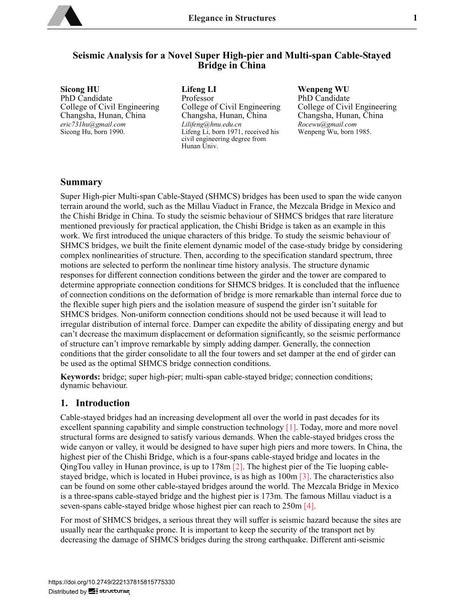Seismic Analysis for a Novel Super High-pier and Multi-span Cable-Stayed Bridge in China

|
|
|||||||||||
Bibliografische Angaben
| Autor(en): |
Sicong Hu
Lifeng Li Wenpeng Wu |
||||
|---|---|---|---|---|---|
| Medium: | Tagungsbeitrag | ||||
| Sprache(n): | Englisch | ||||
| Tagung: | IABSE Conference: Elegance in structures, Nara, Japan, 13-15 May 2015 | ||||
| Veröffentlicht in: | IABSE Conference Nara 2015 | ||||
|
|||||
| Seite(n): | 352-353 | ||||
| Anzahl der Seiten (im PDF): | 8 | ||||
| Jahr: | 2015 | ||||
| DOI: | 10.2749/222137815815775330 | ||||
| Abstrakt: |
Super High-pier Multi-span Cable-Stayed (SHMCS) bridges has been used to span the wide canyon terrain around the world, such as the Millau Viaduct in France, the Mezcala Bridge in Mexico and the Chishi Bridge in China. To study the seismic behaviour of SHMCS bridges that rare literature mentioned previously for practical application, the Chishi Bridge is taken as an example in this work. We first introduced the unique characters of this bridge. To study the seismic behaviour of SHMCS bridges, we built the finite element dynamic model of the case-study bridge by considering complex nonlinearities of structure. Then, according to the specification standard spectrum, three motions are selected to perform the nonlinear time history analysis. The structure dynamic responses for different connection conditions between the girder and the tower are compared to determine appropriate connection conditions for SHMCS bridges. It is concluded that the influence of connection conditions on the deformation of bridge is more remarkable than internal force due to the flexible super high piers and the isolation measure of suspend the girder isn't suitable for SHMCS bridges. Non-uniform connection conditions should not be used because it will lead to irregular distribution of internal force. Damper can expedite the ability of dissipating energy and but can't decrease the maximum displacement or deformation significantly, so the seismic performance of structure can't improve remarkable by simply adding damper. Generally, the connection conditions that the girder consolidate to all the four towers and set damper at the end of girder can be used as the optimal SHMCS bridge connection conditions. |
||||
| Stichwörter: |
Brücke dynamisches Verhalten
|
||||

